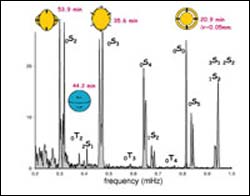Tsunami earthquake triggered Earth’s free oscillations

Spectral peaks of Earth’s free oscillations, indicated by the shapes of vibration deformations of Earth’s sphere.
Oscillations begun by the Sumatra-Andaman earthquake in December 2004 are providing important information about the composition of the Earth as well as the size and duration of the earthquake, according to a report in the journal Science by an international group of scientists led by Professor Jeffrey J. Park of the Department of Geology and Geophysics at Yale University.
“Just like thumping a watermelon to hear if it is ripe, after a big earthquake thumps our planet we measure the natural tones from seismograms to detect properties of Earth’s deep mantle and core,” said Park. “The Sumatra-Andaman earthquake produced the best documentation of Earth’s free oscillations ever recorded.”
Free oscillations have natural periods that depend on the composition and temperature of Earth’s deep interior, and cause tiny distortions in the shape of the planet.
“This earthquake may resolve several controversies, such as whether a heavy slagheap of old tectonic plates is stuck near the core-mantle boundary beneath Africa, or even whether microscopic crystals of pure iron in Earth’s inner core are aligned with the rotation axis,” said Park.
Seismic waves from the 9.0-magnitude Sumatra earthquake reached a monitoring station in Sri Lanka within four minutes and caused the ground to rise and fall 3.6 inches (9.0 centimeters); it registered on seismometers worldwide within 21 minutes. To give a sense of relative magnitudes, the Northridge, California quake in 1994 lasted 20 seconds or less; the data of Park and his collaborators supports a model of the Sumatra-Andaman earthquake that lasted about 10 minutes. The rupture moved massive slabs of rock at least 65 feet (20 meters) over the longest distance ever recorded, more than 800 miles (1300 kilometers) -– the equivalent of the distance from Florida to New England.
“The terrible damage and loss of life wrought by this earthquake humbles the most dispassionate observer, as does the strong likelihood that one or more [similar] earthquakes will occur elsewhere in the coming century,” said Park. In the 1950’s and 1960’s there were three earthquakes of this magnitude in the area near sparsely inhabited Aleutian Islands.
The first report of free oscillations was from hand-digitized analogue recordings of the 9.0+ magnitude Chilean earthquake on 22 May 1960. The seismic records from the 1960’s events were fragmentary, because the technology of the time could not record all earthquake motions. When seismic waves from the largest earthquakes arrived at the old-design seismometers, they simply jumped off-scale, or even broke. More recently, digital recordings of smaller, deeper quakes have better records of free oscillations and more accurate reference models of Earth’s interior.
The Sumatra-Andman earthquake tested the current global digital broadband technology. More than 400 stations around the world provided data, including a site at the South Pole with a seismometer buried deep in the ice sheet.
With the network now online, and with the planned addition of more seismograph locations into the system, strong seismic events in the future can be continuously monitored in unprecedented detail from the instant when the first signals arrive at monitoring stations. Oscillation studies, in combination with other geodetic information, can be applied to seismically active regions worldwide.
Media Contact
All latest news from the category: Earth Sciences
Earth Sciences (also referred to as Geosciences), which deals with basic issues surrounding our planet, plays a vital role in the area of energy and raw materials supply.
Earth Sciences comprises subjects such as geology, geography, geological informatics, paleontology, mineralogy, petrography, crystallography, geophysics, geodesy, glaciology, cartography, photogrammetry, meteorology and seismology, early-warning systems, earthquake research and polar research.
Newest articles

Time to Leave Home? Revealed Insights into Brood Care of Cichlids
Shell-dwelling cichlids take intense care of their offspring, which they raise in abandoned snail shells. A team at the Max Planck Institute for Biological Intelligence used 3D-printed snail shells to…

Smart Fabrics: Innovative Comfortable Wearable Tech
Researchers have demonstrated new wearable technologies that both generate electricity from human movement and improve the comfort of the technology for the people wearing them. The work stems from an…

Going Steady—Study Reveals North Atlantic’s Gulf Stream Remains Robust
A study by the University of Bern and the Woods Hole Oceanographic Institution in the USA concludes that the ocean circulation in the North Atlantic, which includes the Gulf Stream,…



